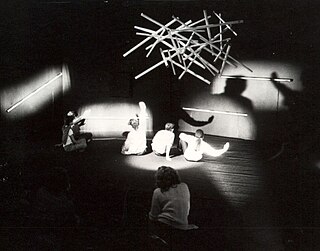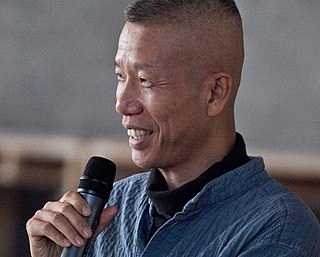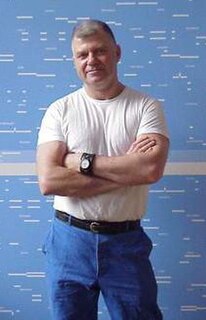Related Research Articles

Interactive art is a form of art that involves the spectator in a way that allows the art to achieve its purpose. Some interactive art installations achieve this by letting the observer or visitor "walk" in, on, and around them; some others ask the artist or the spectators to become part of the artwork.
Keith Tyson is an English artist. In 2002, he was the winner of the Turner Prize. Tyson works in a wide range of media, including painting, drawing and installation.

Matthew Barney is an American contemporary artist and film director who works in the fields of sculpture, film, photography and drawing. His works explore connections among geography, biology, geology and mythology as well as themes of conflict and failure. His early pieces were sculptural installations combined with performance and video. Between 1994 and 2002, he created The Cremaster Cycle, a series of five films described by Jonathan Jones in The Guardian as "one of the most imaginative and brilliant achievements in the history of avant-garde cinema." He is also known for Drawing Restraint 9 (2005), River of Fundament (2014) and Redoubt (2018), as well as his past relationship with Icelandic musician Björk.

Solomon "Sol" LeWitt was an American artist linked to various movements, including conceptual art and minimalism.

Barbara Nessim is an American artist, illustrator, and educator.

Ellsworth Kelly was an American painter, sculptor, and printmaker associated with hard-edge painting, Color Field painting and minimalism. His works demonstrate unassuming techniques emphasizing line, color and form, similar to the work of John McLaughlin and Kenneth Noland. Kelly often employed bright colors. He lived and worked in Spencertown, New York.

Doug Aitken is an American artist. Aitken was born in Redondo Beach, California in 1968. Aitken's body of work ranges from photography, print media, sculpture, and architectural interventions, to narrative films, sound, single and multi-channel video works, installations, and live performance.
Mel Chin is a conceptual visual artist. Motivated largely by political, cultural, and social circumstances, Chin works in a variety of art media to calculate meaning in modern life. Chin places art in landscapes, in public spaces, and in gallery and museum exhibitions, but his work is not limited to specific venues. Chin once stated: “Making objects and marks is also about making possibilities, making choices—and that is one of the last freedoms we have. To provide that is one of the functions of art.”
Liu Wei is a Chinese artist based in Beijing. He works in varied media – video, installation, drawing, sculpture, and painting – with no uniting stylistic tendency, though the Saatchi Gallery finds a uniting theme of "a sentiment of excess, corruption, and aggression reflective of cultural anxiety". Conceptualism, satire, and humor are the hallmarks of his works.

Cai Guo-Qiang is a Chinese artist who currently lives and works in New York City and New Jersey.

Nathaniel Stern is an American/South African interdisciplinary artist who works in a variety of media, including photography, interactive art, public art interventions, installation, video art, net.art and printmaking. He is currently a Professor of Art and Mechanical Engineering at the University of Wisconsin–Milwaukee.

Terry Winters is an American painter, draughtsman, and printmaker whose nuanced approach to the process of painting has addressed evolving concepts of spatiality and expanded the concerns of abstract art. His attention to the process of painting and investigations into systems and spatial fields explores both non-narrative abstraction and the physicality of modernism. In Winters’ work, abstract processes give way to forms with real word agency that recall mathematical concepts and cybernetics, as well as natural and scientific worlds.
Douglas Matthew Davis, Jr. was an American artist, critic, teacher, and writer for among other publications Newsweek.

Keith Milow is a British artist. He grew up in Baldock, Hertfordshire, and lived in New York City (1980–2002) and Amsterdam (2002–2014), now lives in London. He is an abstract sculptor, painter and printmaker. His work has been characterised as architectural, monumental, procedural, enigmatic and poetical.

Eva & Franco Mattes are a duo of artists based in New York City. Since meeting in Berlin in 1994, they have never separated. Operating under the pseudonym 0100101110101101.org, they are counted among the pioneers of the Net Art movement and are known for their subversion of public media. They produce art involving the ethical and political issues arising from the inception of the Internet. They are based in Brooklyn, New York, but also travel frequently throughout Europe and the United States.

New media art includes artworks designed and produced by means of electronic media technologies, comprising virtual art, computer graphics, computer animation, digital art, interactive art, sound art, Internet art, video games, robotics, 3D printing, and cyborg art. The term defines itself by the thereby created artwork, which differentiates itself from that deriving from conventional visual arts. New Media art has origins in the worlds of science, art, and performance. Some common themes found in new media art include databases, political and social activism, Afrofuturism, feminism, and identity, a ubiquitous theme found throughout is the incorporation of new technology into the work. The emphasis on medium is a defining feature of much contemporary art and many art schools and major universities now offer majors in "New Genres" or "New Media" and a growing number of graduate programs have emerged internationally. New media art may involve degrees of interaction between artwork and observer or between the artist and the public, as is the case in performance art. Yet, as several theorists and curators have noted, such forms of interaction, social exchange, participation, and transformation do not distinguish new media art but rather serve as a common ground that has parallels in other strands of contemporary art practice. Such insights emphasize the forms of cultural practice that arise concurrently with emerging technological platforms, and question the focus on technological media per se. New Media art involves complex curation and preservation practices that make collecting, installing, and exhibiting the works harder than most other mediums. Many cultural centers and museums have been established to cater to the advanced needs of new media art.
William Lamson is an American installation artist, performance artist, and generative artist. He was born in Arlington, Virginia, and currently lives and works in Brooklyn, New York. Within his artistic career, he works both in the natural world and in his studio. His playful interaction with his environment includes small performances and actions that are captured on video. His diverse artistic practice involves working with elemental forces to create durational performative actions.

Ryota Kuwakubo is a Japanese multimedia artist. Kuwakubo was born in Tochigi Prefecture. In 1998 he co-produced the project BITMAN with the art unit Maywa Denki. Kuwakubo works with varying mediums, most commonly utilizing digital or electronic aspects, and a typical theme his works center on is contrasting matter.
Robin Winters is an American conceptual artist and teacher based in New York. Winters is known for creating solo exhibitions containing an interactive durational performance component to his installations, sometimes lasting up to two months. As an early practitioner of Relational Aesthetics Winters has incorporated such devices as blind dates, double dates, dinners, fortune telling, and free consultation in his performances. Throughout his career he has engaged in a wide variety of media, such as performance art, film, video, writing prose and poetry, photography, installation art, printmaking, drawing, painting, ceramic sculpture, bronze sculpture, and glassblowing. Recurring imagery in his work includes faces, boats, cars, bottles, hats, and the fool.
Copper Giloth is a new media artist based in Amherst, Massachusetts. Giloth's work involves digital media, mobile art, virtual environments, animations, videos, painting, and installations, and have been influenced by elements of her life such as her parents. She, along with Darcy Gerbarg, helped organize art exhibitions that showed alongside the SIGGRAPH conference, marking the exhibitions as the first to be shown at the conference. Giloth has been described as "one of the leading exponents of computer art".
References
- ↑ "23030768". viaf.org. Retrieved 5 December 2021.
- ↑ "Matthew Ritchie". Art21. Retrieved 5 December 2021.
- ↑ "Hutton, Molly. Matthew Ritchie: In the Anderson Collection. The Anderson Collection" (PDF). Retrieved 5 December 2021.
- ↑ Matthew Ritchie, The New Place Archived 3 October 2009 at the Wayback Machine , 2001. San Francisco Museum of Modern Art, 1 January 2001 – 1 January 2002
- ↑ "Matthew Ritchie: The Iron City - Saint Louis Art Museum - absolutearts.com". www.absolutearts.com. Retrieved 15 November 2019.
- ↑ Bell, Julian (1 January 2013). Contemporary Art and the Sublime. Tate. ISBN 978-1-84976-387-5.
- ↑ "The Database as System and Cultural Form: Anatomies of Cultural Narratives" in Database Aesthetics. Art in the Age of Information Overflow Archived 6 February 2011 at the Wayback Machine